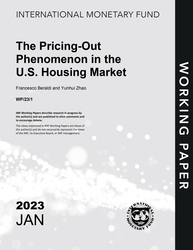
The Pricing-Out Phenomenon in the U.S. Housing Market
The Pricing-Out Phenomenon in the U.S. Housing Market
READ MORE...
Volume/Issue:
Volume 2023
Issue 001
Publication date: January 2023
ISBN: 9798400228230
$0.00
Add to Cart by clicking price of the language and format you'd like to purchase
Available Languages and Formats
| English |
Topics covered in this book
This title contains information about the following subjects.
Click on a subject if you would like to see other titles with the same subjects.
Inflation , Economics- Macroeconomics , Economics / General , Pricing-Out , U , S , Housing Market , Housing Affordability , Distributional Effects , Monetary Policy , housing affordability , pricing-out effect , pricing-out phenomenon , first-time homebuyer , equilibrium effect , Housing prices , Housing , Income , Mortgages , Inflation , Asia and Pacific
Summary
The COVID-19 pandemic further extended the multi-year housing boom in advanced economies and emerging markets alike against massive monetary easing during the pandemic. In this paper, we analyze the pricing-out phenomenon in the U.S. residential housing market due to higher house prices associated with monetary easing. We first set up a stylized general equilibrium model and show that although monetary easing decreases the mortgage payment burden, it would raise house prices, lower housing affordability for first-time homebuyers, and increase housing wealth inequality between first-time and repeat homebuyers. We then use the U.S. household-level data to quantify the effect of the house price change on housing affordability relative to that of the interest rate change. We find evidence of the pricing-out effect for all homebuyers; moreover, we find that the pricing-out effect is stronger for first-time homebuyers than for repeat homebuyers. The paper highlights the importance of accounting for general equilibrium effects and distributional implications of monetary policy while assessing housing affordability. It also calls for complementing monetary easing with well-targeted policy measures that can boost housing affordability, particularly for first-time and lower-income households. Such measures are also needed during aggressive monetary tightening, given that the fall in house prices may be insufficient or too slow to fully offset the immediate adverse impact of higher rates on housing affordability.
Copyright © 2010 - 2025
Powered by:
AIDC



